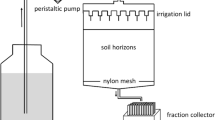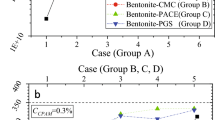Abstract
LABORATORY experiments carried out by Hadaway and Barlow1,2 and by Downs, Bordas and Navarro3 have shown that solid particles of DDT may disappear from the surface of various types of soils such as are frequently used for the construction of huts in the tropics. It seemed that this disappearance was due to a process of absorption, and the different types of soils vary in their sorptive properties4.
This is a preview of subscription content, access via your institution
Access options
Subscribe to this journal
Receive 51 print issues and online access
$199.00 per year
only $3.90 per issue
Buy this article
- Purchase on Springer Link
- Instant access to full article PDF
Prices may be subject to local taxes which are calculated during checkout
Similar content being viewed by others
References
Hadaway, A. B., and Barlow, F., Nature, 167, 854 (1951).
Hadaway, A. B., and Barlow, F., Bull. Ent. Res., 43, 281 (1952).
Downs, W. G., Bordas, E., and Navarro, L., Science, 114, 259 (1951).
Barlow, F., and Hadaway, A. B., Bull. Ent. Res., 46, 547 (1955).
Rajindar Pal and Sharma, M. I. D., Ind. J. Malar., 6, 251 (1952).
Hadaway, A. B., W.H.O. Bull., 14, 813 (1956).
Author information
Authors and Affiliations
Rights and permissions
About this article
Cite this article
GEROLT, P. Improved Persistence of Dieldrin Deposits on Sorptive Mud Surface. Nature 180, 394–395 (1957). https://doi.org/10.1038/180394a0
Issue Date:
DOI: https://doi.org/10.1038/180394a0
Comments
By submitting a comment you agree to abide by our Terms and Community Guidelines. If you find something abusive or that does not comply with our terms or guidelines please flag it as inappropriate.



